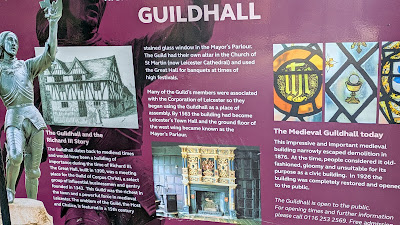 |
| Richard III, outside the Cathedral |
We had a wonderful day in Leicester, where I’ve not lived for more than 42 years. I hardly recognized it – I had to keep reorienting myself as to where I was. We weren’t that far from where I worked at the Leicestershire School of Music, but the downtown core has changed a lot, and Steve tells me that the population is the most culturally diverse in England, with people from many countries moving to the area.
 |
| The Cathedral spire, where the peregrines are nesting |
Our focus was a display that Steve and Gill had brought Zander to, a while back, but ended up not taking the time they would liked – so they were really glad to come again. We arrived at Leicester Cathedral to find the focus was unexpected – the local ornithological society was out in force to draw attention to the peregrine falcons nesting in the Cathedral spire, and we had a fascinating conversation with one of the experts from
Leicester Peregrines.
 |
| Hearing about the peregrines |
Fascinating as they were, what we were there for was something much older. My British history is a little rusty, but I’ve always been fascinating by the Wars of the Roses, fought up and down England 1455-1487. They pitted the House of Lancaster (white rose) and the House of York (red rose) against each other, and Lancaster won, in the person of Henry Tudor, who became Henry VII. The last Yorkist was Richard III, killed at the Battle of Bosworth – Bosworth is to the east of Leicester – and his body was reputedly buried at a GreyFriars monastery in the city, but the monastery was demolished during the Dissolution of the Monasteries in the 16th century.


Richard III was considered the villain of the time for many years, mostly thanks to Shakespeare’s portrait of him in the play – but we have to remember that the portrait came to us through Tudor eyes. With the Tudors out of the way, there was a strong move to reinstate his reputation, and the Richard III Society became strong about a hundred years ago.
Wikipedia has it in detail, if you’re interested - but the short form of it is that they excavated a City Council parking lot, and discovered remains that were linked by DNA to the dead king who was exhumed and finally reburied in the Cathedral.
 |
| Looking down on the grave-site |
The exhibition was wonderful – history in detail, but also presented in a way that was accessible and interesting. (Just not always photographable!) We ended up at the excavation site where heavy glass panels covered the space where the skeleton was found, and the curve of his scoliosis spine was evident.
And when we went for coffee afterwards, we were left in no doubt about where we were!
 |
| Gill & Steve suffering from the plague! |

 |
| In the courtyard of the Guildhall Museum |
 |
| The Mayor's Parlour |
We walked over to the Cathedral only to find that it was closed until 1:30, so we went on to the Guildhall museum which none of us had known – beautifully preserved and presented.
 |
| The grand hall |
 |
Beautiful old period furniture - with warning signs.
This one says
"Everyone who has ever sat on this chair is now dead.
Play it safe and remain standing." |
 |
| Downstairs in the jail |
We found lunch at a wonderful little Buddhist centre just behind the Cathedral with the most fabulous vegetarian/vegan food – yum, yum! - and then we returned to the Cathedral. Richard III was reinterred there in 2015, but in the last five years, they have had a mandate to do some major renewal work – archeology, structural .work, providing a new level stone floor throughout (including underfloor heating); replacing failing infrastructure such as boilers, electrical system; installing new lighting and audio-visual systems; restoring/revealing architectural features; and repairing much that had deteriorated (particularly stonework and décor).
The building is more large-parish-church style than big cathedral – it was St Martin’s Church until 1927 when the diocese of Leicester was established. They have done some wonderful display work – video and signage – and the Heritage site attached has both Roman and Plantagenet content. Really interesting stuff!
 |
The locally made pall which covered the coffin at the reinterment.
This side showed images from Richard's time; the other side included images
of those involved in rediscovering him this century |
.
 |
| The new bishop's throne |
 |
| Richard III's tomb |
We did a downtown walk around the market place and the old town hall before we headed for home – Steve to make curry, Gill to do necessary chores, and me to indulge in Wimbledon. I watched Sabalenka go forward, American Fritz, and then partway through the game between Carlos Alcaraz and Cam Norrie I got called to dinner and missed the rest of it! I might get some tomorrow afternoon, but I’ll be out tomorrow evening and Thursday as well, so I need to make the most of it tonight.

























No comments:
Post a Comment